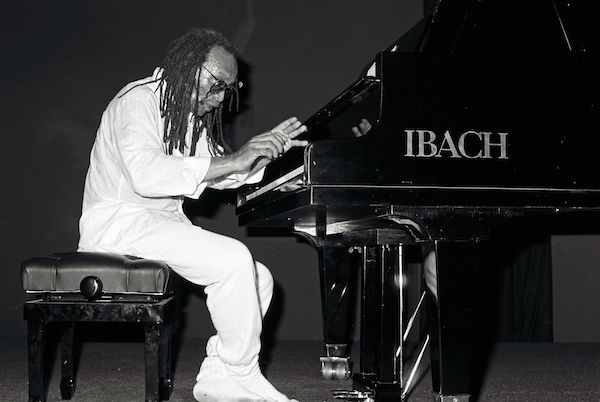Oct 28, 2025 10:47 AM
In Memoriam: Jack DeJohnette, 1942–2025
Jack DeJohnette, a bold and resourceful drummer and NEA Jazz Master who forged a unique vocabulary on the kit over his…

Cecil Taylor—shown here performing in Cologne, Germany, in 1987—died April 5. He was 89.
(Photo: Hyou Vielz)Trumpeter Eddie Gale only made one album—the legendary 1966 Unit Structures on Blue Note—with pianist Cecil Taylor, the pioneer avant-garde pianist who died on April 5 at the age of 89. But out of a short period of rehearsal and that one afternoon of recording, Gale walked away with a lifelong friend and a crucial piece of advice that he says helped change his perspective on music.
“Cecil said to me, ‘Always be interested in listening to all types of music,’” Gale said. “‘Always be open to listening.’”
That kind of openness and attention might not be immediately apparent when listening to Taylor’s work on innumerable studio recordings and in countless concert appearances where it often seemed as if the pianist was attempting to flood the room with notes and volume. But throughout his long career, the late pianist absorbed a variety of styles and genres—jazz, blues, gospel, classical, world music—and used them to color and shade his singular sound and approach to his chosen instrument.
“People call it ‘free jazz,’ but that’s not really a sufficient or even accurate description of what he’s doing,” said Vijay Iyer, a celebrated pianist who cites Taylor as a major influence. “There’s so much care, even in the fusillade things he would do with both hands on the keyboard. It’s precise. And especially when you land on these ballad passages, and these delicate arpeggiated things he would do. The range of his sound and his touch, it’s done with great wisdom and care.”
Taylor was born March 29, 1929, in Long Island City, Queens. The son of a chef and a homemaker, he was urged forward in his pursuit of a career as a musician by his mother—she insisted he practice the piano six days a week—and through his studies at the New York College of Music, as well as at the New England Conservatory. When he started playing professionally, in jam sessions and with a quartet he put together with soprano saxophonist Steve Lacy and bassist Buell Neidlinger (who died March 16), his music was in line with the bop sounds of the day, though cut through with spikes of jagged rhythm and brusque atonality.
It wasn’t until the sessions that yielded his two Blue Note albums—Unit Structures and Conquistador, both released in ‘66—that Taylor’s vision was fully revealed. Both records eschewed the traditional structures of jazz songwriting, opting for more fluid and untethered playing. There were no melodies as such, just quick snapshot-phrases that were deconstructed and reconfigured by Taylor and a band that included Gale, bassists Alan Silva and Henry Grimes, and drummer Andrew Cyrille, among others.
“I was washing dishes in a restaurant at the same time I was being written about in places like DownBeat,” Taylor told journalist Gene Santoro for a story that originally ran in the June 1990 edition of the magazine. “And it was very good for me, because I had to decide what I really wanted to do. Did I want to pursue my ideals badly enough? It was the only way to learn that I did.”
Taylor’s material was rarely completely freeform, however. As bassist William Parker, who first played with the pianist in 1980, remembered, he was given a lot of space to move, but there were guideposts to help him along the way.
“He would play phrases or sounds on the piano and then interpret the information and give it out to the musicians,” Parker remembered. “Then you began to interpret if as you liked. Even though he was telling you, ‘F-sharp off the B-flat, down to C, down to D-flat and up a third,’ you could interpret it the way you wanted to. As I recall, he would never say, ‘It goes this way. You’re playing it wrong.’ He would never use the word ‘wrong.’ You were empowered to make a contribution.”
Throughout his 60-year career, Taylor would seek out the contributions of many players from throughout the worlds of jazz and experimental music. His frequent collaborators included composer Pauline Oliveros, bassist Sirone, saxophonist Evan Parker, and drummers Tony Oxley and Max Roach.
As is the case with many avant-garde players, Taylor quickly earned a rabid following in Europe, which is where the majority of his sessions and live recordings from the latter half of his life were captured. Of particular importance was the month-long residency he did in East Berlin as part of a European City of Culture celebration. Taylor played solo and in ensembles large and small, including a performance with guitarist Derek Bailey. To kick off this run of shows, he held an open invitation for young jazz musicians to work with him on an extensive piece called “Legba Crossing.” While many of the players were from Germany, saxophonist Biggi Vinkeloe got wind of the opportunity and traveled to Berlin from her home in France to be part of the performance.
“I know that many people thought that it was organized chaos,” Vinkeloe recently said. “It was extremely precise, and he had incredible ears. I remember there were a lot of wind instruments, mostly saxophones, so it was extremely loud. So, I switched to flute, thinking that if everybody sees me playing flute, the volume would come down. All of the sudden, he stops the orchestra and starts screaming, ‘What are you thinking? Have any of you heard the flute? I know that you didn’t.’”
During the final decade of his life, Taylor’s performance schedule slowed considerably, but his reputation as an innovator continued to grow. Admiration for the pianist culminated in events like “A Celebration of the Maestro,” which took place at New York’s Issue Project Room in 2012 and featured tributes to the musician from Iyer, Craig Taborn and Amina Claudine Meyers, and last year’s “Open Plan,” which featured Taylor performing with Oxley and dancer Min Tanaka at New York’s the Whitney Museum.
Taylor was inducted into the DownBeat Hall of Fame via the 1975 Critics Poll, and he was named an NEA Jazz Master in 1990. Among the other honors he amassed were a MacArthur fellowship in 1991 and the Kyoto Prize in 2014.
While Taylor leaves behind no immediate family members, heirs to his music constitute a new generation of players and listeners.
“I think the mission of the next 60 years should be to try to unpack what the hell he was doing,” Iyer said, laughing. “If you spend any length of time with his actual music, then you see there’s all this detail and this rich, endless well of information. There’s all this stuff to learn from it.” DB

Jack DeJohnette boasted a musical resume that was as long as it was fearsome.
Oct 28, 2025 10:47 AM
Jack DeJohnette, a bold and resourceful drummer and NEA Jazz Master who forged a unique vocabulary on the kit over his…

D’Angelo achieved commercial and critical success experimenting with a fusion of jazz, funk, soul, R&B and hip-hop.
Oct 14, 2025 1:47 PM
D’Angelo, a Grammy-winning R&B and neo-soul singer, guitarist and pianist who exerted a profound influence on 21st…

To see the complete list of nominations for the 2026 Grammy Awards, go to grammy.com.
Nov 11, 2025 12:35 PM
The nominations for the 2026 Grammy Awards are in, with plenty to smile about for the worlds of jazz, blues and beyond.…

Jim McNeely’s singular body of work had a profound and lasting influence on many of today’s top jazz composers in the U.S. and in Europe.
Oct 7, 2025 3:40 PM
Pianist Jim McNeely, one of the most distinguished large ensemble jazz composers of his generation, died Sept. 26 at…

Drummond was cherished by generations of mainstream jazz listeners and bandleaders for his authoritative tonal presence, a defining quality of his style most apparent when he played his instrument unamplified.
Nov 4, 2025 11:39 AM
Ray Drummond, a first-call bassist who appeared on hundreds of albums as a sideman for some of the top names in jazz…






